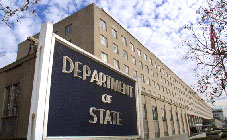
US Department of State evaluates money laundering risks in Georgia
By Khatia Bzhalava
Thursday, March 4
On March 2, the US Department of State released the 2021 Money Laundering report, which reads that the overall number of money laundering cases in Georgia is low in 2020 compared to the number of predicate offenses. The report also says that the current economic situation in Georgia creates a convenient ground for money launderers.
The US Department of State reports that in June 2020, the Financial Monitoring Service of Georgia and the Financial Investigation Department adopted new regulations to define the future of Georgia’s AML/CFT (anti-money laundering program) regulatory framework. Georgian law enforcement has exercised monitoring mechanisms set up in recent years to detect links between drugs, organized crime, and money laundering. The report also says that the considerable illegal income in Georgia comes from bank fraud and cybercrime. The US Department of State notes that cryptocurrency, which is not regulated in Georgia, should be addressed, along with the gaming industry.
“The general economic situation in Georgia, which is far from a developed one, forms a fruitful ground for money launderers to find frontmen. Ease of doing business, which enhances Georgia’s attractiveness for clean investments, is a vehicle for ill-gotten funds to enter the financial system. Cryptocurrency is unregulated in Georgia, increasing vulnerability to money laundering,” reads the report.
Based on the monitoring mechanism established in previous years, prosecutors identified links between drugs, organized crime, and money laundering. The US Department of State believes that the uncontrolled growth of the gaming industry, including internet gaming, is concerning.
According to the report, Georgia continues to be a popular virtual currency mining location as bitcoin and other virtual currencies are extremely popular. It is also noted that Georgia has an adequate legal and institutional framework for investigating and prosecuting money laundering offenses, however, the country lacks experienced cybercrime labs and has few qualified digital forensic analysts. The Prosecution Service of Georgia (PSG) recently created a new cybercrime department and is currently in the process of developing cryptocurrency seizure guidelines, which will be used by law enforcement.
The report shows that the number of STRs (Suspicious Transaction Report) submitted by gaming businesses has increased from 1 (2018) to 10 (2020).
“This change is attributed to government efforts to establish monitoring departments within gaming entities, develop guidelines on the reporting requirements for gaming businesses, and implement awareness-raising programs. However, the overall number of reports is still suspiciously low and may indicate the gaming industry may not be fully complying with existing regulations,” reads the report.
Georgia’s 2019 money laundering risks are assessed as medium and terrorism financing risks as low. The report reads that “Georgia has policy-level interagency cooperation but lacks a taskforce approach at the operational level.” The US Department of State believes Georgia should take steps to supervise and improve regulation of its gaming industry, and Georgian prosecutors and law enforcement authorities should continue to emphasize pursuing links between organized crime and money laundering.
Another report of The US Department of State on Drug and Chemical Control reads that due to the COVID-19 crisis, domestic drug use has increased in Georgia, particularly narcotics purchased via crypto-currency on the Dark Web. The report mentions that the Georgian government closed the country’s borders in March 2020 to avoid the spread of the coronavirus, which, according to the Ministry of Internal Affairs is a probable cause of a 66 percent decrease in drug smuggling from January to August of 2020 compared to the same period in 2019. The report notes that the overall drug-related crimes in Georgia decreased by approximately 32 percent in the same period.


